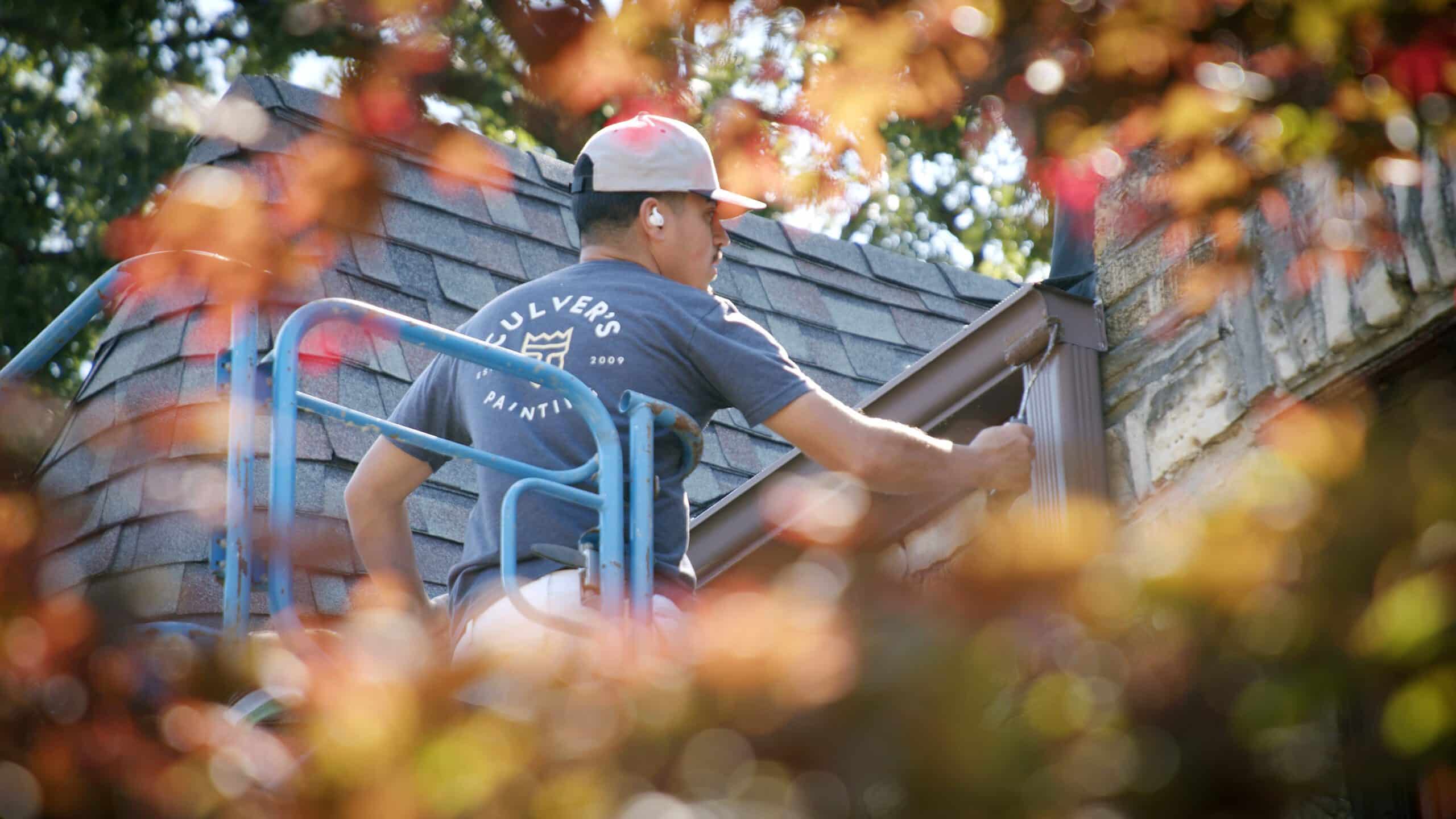In Wisconsin, the harsh and unpredictable weather can be tough on aluminum siding. Proper painting and maintenance of aluminum siding can protect your home and boost its appearance. This guide covers how to paint aluminum siding in Wisconsin, from the preparation steps, to the best materials to use, and tips for a long-lasting finish. We’ll also cover how hiring aluminum siding painting services like Culver’s Painting can save a lot of time, energy, and frustration.
Key Takeaways
- Painting aluminum siding protects a home’s exterior from harsh weather and is more economical than replacement, enhancing both appearance and value.
- Proper preparation is essential, including cleaning, inspecting for damages, and using suitable primers and paints for durability.
- Regular maintenance and timely inspections can extend the life of painted aluminum siding, with a recommended repainting schedule of every 6-10 years.
Understanding Aluminum Siding Painting

Aluminum siding is popular for a reason: It’s extremely durable and weather-resistant. But over time, exposure to elements can cause the paint on aluminum to degrade, leading to unsightly and potentially damaging issues. Periodically re-painting your vinyl or aluminum siding keeps it resilient against Wisconsin’s climate, providing a durable shield for your home’s exterior.
Re-painting older aluminum siding is usually more economical than replacing it. Plus, a fresh coat of paint can breathe new life into your home’s exterior without the hefty price tag of new siding.
With these benefits in mind, let’s delve into how to prepare your aluminum siding for a fresh coat of paint.
Preparing Aluminum Siding for Painting
Proper preparation is crucial for a successful paint job on aluminum siding. In fact, painting is one of the final steps.
If you skip the preparation process, the paint won’t adhere correctly, it won’t look good, and it won’t last. It’s also important to check for powdery paint pigment as a sign of deterioration.
For us, the prep process includes inspecting and repairing the siding, preparing a cleaning solution, and deploying safe power washing techniques. Finally, cleaning and drying the surface before painting is mandatory for a long-lasting, professional finish.
Let’s break down these steps in some more detail.
Inspecting and Repairing Siding
Conduct regular inspections of your aluminum siding to identify potential damage or degradation before painting. During inspections, we look for common issues like mildew, chalking, dents, and scratches. These problems can affect the final appearance and durability of your paint job if not addressed.
Addressing any detected issues is crucial for a smooth and long-lasting paint finish. We seal gaps around windows and doors with a high-grade exterior caulk can prevent future damage and ensure a seamless look. Addressing these repairs not only contributes to a better paint finish but also extends the life of your siding.
When you hire Culver’s Painting to paint your aluminum siding, you’re not just hiring us to paint. We make sure that every step in the preparation process is done first, which starts with a careful inspection of the entire exterior surface to find any issues and offer solutions before painting begins.
Cleaning and Power Washing Techniques
Using a proper cleaning solution can be helpful in preparing aluminum siding for painting. A common and cost effective mixture includes chlorine bleach, trisodium phosphate (TSP), and water. This combination helps remove dirt, grime, and any mildew, ensuring the surface is clean and ready for painting.
Power washing is the most important step in preparing aluminum siding for painting. It effectively removes dirt and grime, providing a clean surface for the paint to adhere to. When power washing, always spray downward to prevent water from being forced beneath and getting trapped between the siding panels.
We ensure the siding is completely dry after power washing before starting the painting process; moisture can affect paint adhesion and lead to poor results. The Culver’s crew comes to your property one full week ahead of painting to power wash your exterior siding, allowing it to completely dry before we start applying siding paint.
Choosing the Right Materials and Paint
Choosing the right materials and paint is crucial for ensuring both durability and aesthetic appeal on vinyl and aluminum siding, as well as metal surfaces. We highly recommend acrylic exterior paint due to its strong adhesion and durability. This type of paint is designed to withstand harsh weather conditions, making it ideal for painting Wisconsin homes.
At Culver’s, we proudly rely on Sherwin Williams paint products, recognized as one of the top-quality brands for any type of paint product. Selecting the right primer and tools, in addition to paint, can significantly affect the outcome of your painting project. Professional painters understand the specific types of materials required for aluminum siding and metal surfaces, ensuring a high-quality finish that lasts.
Primer Selection
Applying a primer to aluminum siding assists with paint adhesion and longevity. A self-etching primer is particularly beneficial because it enhances the grip of the paint on the metal surface. This step helps seal the siding and prevents oxidation from affecting the paint layer.
Best Paint Types for Aluminum Siding
Acrylic latex paint is favored for its ability to withstand various weather conditions, making it an excellent choice for Wisconsin aluminum siding.
We always SPRAY our exterior paint when possible, with high-end professional paint sprayers that allow for a finer finish than brushing. When necessary, we brush trim or hard-to-reach spots.
Tools Needed for Painting
High-quality brushes and sprayers designed for exterior use are ideal for painting aluminum siding. They make for a better finish and durability of the paint job. Sprayers are particularly effective for covering larger surfaces quickly, making them efficient for painting projects.
Professional equipment for spraying paint, such as airless sprayers, offers smooth application over large areas, enhancing efficiency and providing an even finish.
Painting Process for Aluminum Siding

To paint aluminum siding effectively, thoroughly inspect for damage and clean the surface before application. A clean, dry surface ensures better adhesion and a more professional finish. Lighter shades for aluminum siding can help reduce heat absorption, maintaining the integrity of the paint.
Seasons with milder temperatures and lower humidity are ideal for painting siding. Extreme temperatures can affect paint adherence and drying time, so choosing the right time for your painting project is essential.
Priming or Applying the First Coat of Paint
Depending on the condition of the aluminum siding, we either prime the siding or paint two coats of paint.
Apply the first coat of paint using an airless sprayers, which we use for an even finish and quick coverage. Start at the top and work downward to achieve an even finish and prevent drips when painting.
A roller can help cover larger areas effectively when painting aluminum siding. Two thin coats of paint are more effective than one thick coat, ensuring a better finish and durability.
At Culver’s Painting, we always use two coats of paint for our projects to ensure the highest quality finish for our clients. This practice not only enhances the appearance but also extends the life of the paint job.
Repainting Schedule
Repaint aluminum siding every 6-10 years to maintain its condition. Only sections of aluminum siding that are damaged need to be replaced; fading or weathering can often be addressed with a fresh coat of paint.
A repainting schedule helps maintain the overall appearance and protection of your home’s exterior. Regular repainting keeps your home beautiful and well-protected against the elements.
Why Use a Professional Painting Service to Paint Aluminum Siding in Wisconsin?

Although it’s possible to paint aluminum siding yourself, hiring a professional service like Culver’s Painting saves time, effort, and frustration. Professional painters efficiently manage the entire painting process, freeing homeowners to focus on other important tasks.
Culver’s Painting is known throughout the Madison and Milwaukee areas for our comprehensive interior and exterior painting services for any type of residential or commercial property. With a commitment to exceeding customer expectations, Culver’s Painting provides a personal touch and expertise for the best results.
Summary
Proper preparation, choosing the right materials, and following a detailed painting process ensures a durable and beautiful finish when painting aluminum siding. Regular maintenance and hiring professional painters like Culver’s Painting can extend the life of your paint job and keep your home looking fresh.
Frequently Asked Questions
What areas does Culver’s Painting serve?
We are based in the Milwaukee and Madison areas, and serve all of Southern Wisconsin. Give us a call to get a free estimate.
How often should aluminum siding be painted?
You should repaint aluminum siding every 4-6 years to maintain its appearance and protect it from wear, particularly considering local weather conditions.
What type of paint is best for aluminum siding?
Acrylic exterior paint is the best choice for aluminum siding, as it offers strong adhesion, durability, and resistance to varying weather conditions. Selecting acrylic latex paint will ensure long-lasting protection and an appealing finish.
Why is priming aluminum siding important?
Priming aluminum siding is crucial as it ensures better paint adhesion and enhances the longevity of the finish. Using a self-etching primer can significantly improve the grip of the paint on the metal surface.
Can I paint aluminum siding myself?
Yes, you can paint aluminum siding yourself, but hiring a professional can provide a better finish and save you time and effort. Consider your options based on your skill level and desired outcome.
What maintenance is required for painted aluminum siding?
To maintain painted aluminum siding, you should clean them annually with a mild detergent, perform prompt touch-ups, and conduct regular inspections to catch potential issues. This routine will prolong the life of the paint and keep your home looking its best.









